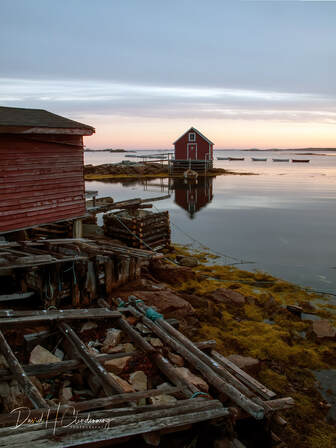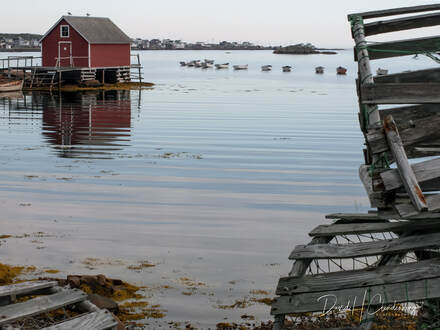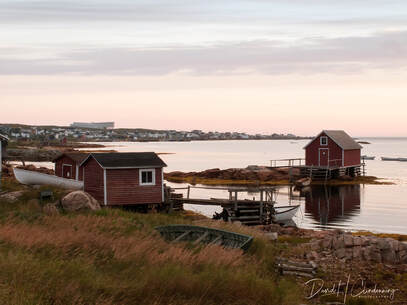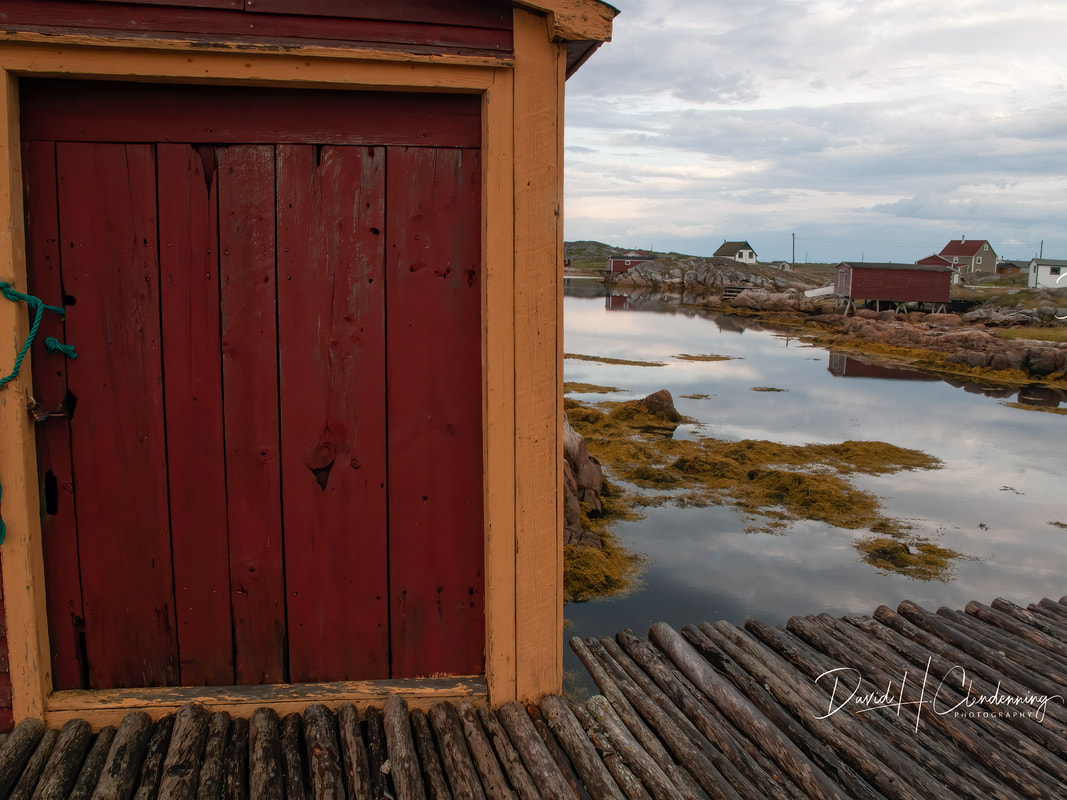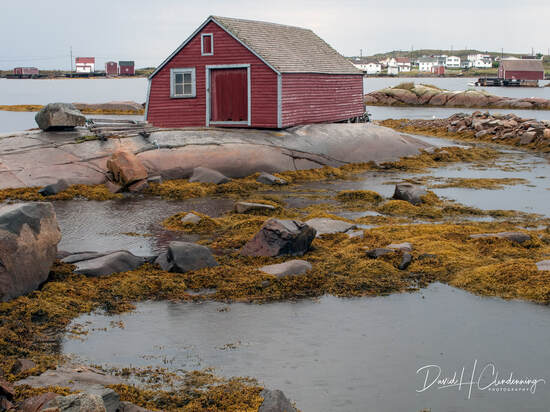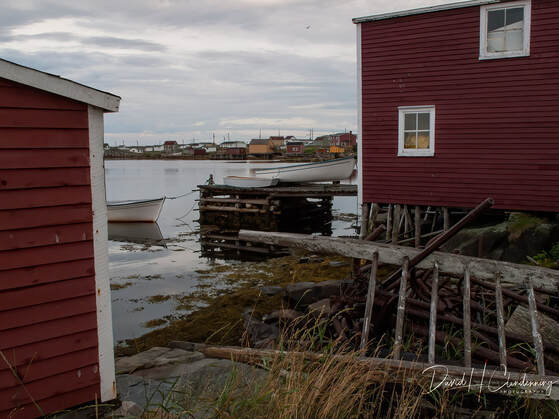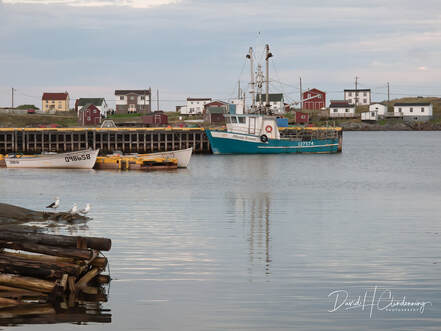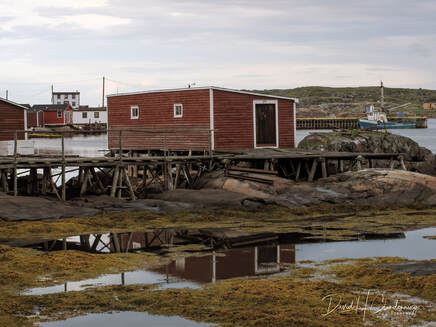Architecture on Fogo Island
Fogo Island Inn - Coastal Modern
Innovative and stylish.
A world class sustainable building
Newfoundland Fishery
The history of the Newfoundland cod fishery dates from the discovery of the North American Continent. Almost immediately English, French, Spanish and Portuguese fisherman began coming annually to Newfoundland waters to fish for cod.
During the early decades of the sixteenth century, these fishermen learned how and where to fish, and how to preserve the fish. The fish were caught by hook and line using sea birds, herring, caplin and squid for bait.
The fishermen would fish off the banks of Newfoundland where fish could always be found. The catch was salted on board the ships and brought back to Europe to be dried and sold. The English fisherman did not have access to the supplies of salt that were available to the others and could not salt their fish to the same extent. They were however able to develop a system which combined light salting for a short period, followed by thorough washing, and then drying in the open air. The result was a light salted product for which Newfoundland eventually became famous.
The early fishery was a truly international affair with the four leading nations of Western Europe participating. However, wars in the late sixteenth century eliminated Spanish and Portuguese fisheries. Thereafter, the Newfoundland cod fishery was shared seasonally every summer, by the English and French. As a result of the wars in the early eighteenth century, France gave up its fishery on the South Coast and received in return the right to fish on the West Coast and Northern Peninsula. They retained this right until 1904 when by mutual agreement they relinquished it to the Newfoundland residents.
These Newfoundland residents were descended from two groups, the fishermen who originally came to fish on a seasonal basis returning to England at the end of each summer and the Irish who came to work with the fishermen and stayed. The fishing ships were gradually replaced by trading ships, which came to exchange goods for fish. In order to maintain a supply of goods, warehouses and mercantile establishments were erected in some fishing ports.
During the early decades of the sixteenth century, these fishermen learned how and where to fish, and how to preserve the fish. The fish were caught by hook and line using sea birds, herring, caplin and squid for bait.
The fishermen would fish off the banks of Newfoundland where fish could always be found. The catch was salted on board the ships and brought back to Europe to be dried and sold. The English fisherman did not have access to the supplies of salt that were available to the others and could not salt their fish to the same extent. They were however able to develop a system which combined light salting for a short period, followed by thorough washing, and then drying in the open air. The result was a light salted product for which Newfoundland eventually became famous.
The early fishery was a truly international affair with the four leading nations of Western Europe participating. However, wars in the late sixteenth century eliminated Spanish and Portuguese fisheries. Thereafter, the Newfoundland cod fishery was shared seasonally every summer, by the English and French. As a result of the wars in the early eighteenth century, France gave up its fishery on the South Coast and received in return the right to fish on the West Coast and Northern Peninsula. They retained this right until 1904 when by mutual agreement they relinquished it to the Newfoundland residents.
These Newfoundland residents were descended from two groups, the fishermen who originally came to fish on a seasonal basis returning to England at the end of each summer and the Irish who came to work with the fishermen and stayed. The fishing ships were gradually replaced by trading ships, which came to exchange goods for fish. In order to maintain a supply of goods, warehouses and mercantile establishments were erected in some fishing ports.
Joe Batt's Arm
Tilting Harbour, UNESCO Site
Outbuildings and Fences in Tilting
Outbuildings for many special purposes were used to supplement house storage requirements, and for fishing and agriculture. Although some outbuildings were clustered around the house, others were dispersed within extended family neighbourhoods. Ownership of these buildings would be impossible to determine by outsiders. Their locations were determined by function, circulations paths, land ownership, garden ownership, and water access rights. Outbuildings were often constructed from materials salvaged from other buildings. Houses were often turned into outbuildings if they had ceased to provide utility as dwellings, most often turning into barns or twine stores. Outbuildings were often sold and moved around the community, and their purpose could change: a fish and carpentry store could later be used as a barn. Most outbuildings were detached, single purpose structures. A few were attached.
Fences in photographs show the three types of traditional fences still present in Tilting and other locations in Newfoundland today: a paling fence, a longer fence and a picket fence. Longer and picket fences were “rinded” (bark removed) to make them last longer. The bark trapped moisture and could lead to decay. Paling fences were always painted.
Fences in photographs show the three types of traditional fences still present in Tilting and other locations in Newfoundland today: a paling fence, a longer fence and a picket fence. Longer and picket fences were “rinded” (bark removed) to make them last longer. The bark trapped moisture and could lead to decay. Paling fences were always painted.
Fogo Island, Newfoundland’s largest offshore island
Tickle your fancy in Newfoundland's Fogo island
At just 25 km long and 14 km wide, community delights with wordplay and its attraction to ‘flat-earthers’
Few corners of Canada can raise a smile through sheer will of words better than Newfoundland and Labrador.
Our youngest province — a piker at just 72 years old, having joined Confederation reluctantly in 1949 — is a cartographer’s delight with its deliciously named tickles and outports and coves.
Wordsmiths can wallow to their Heart’s Content over place names that evoke windswept Ireland, the bitter realities of economic hardship, or the simple whimsy (and a little devilry, no doubt), of the people who have made this region home.
Who can resist being charmed by Joe Batt’s Arm, Tilting, Seldom and Little Seldom?
Even more impressive: they are all located on Fogo Island, itself owing its rather offbeat moniker to the Portuguese term for “island of fire.”
Newfoundland’s largest offshore island, it is located 15 kilometres off the province’s northeast coast and is home to 11 communities — down from 26 at the height of its prosperity — comprising about 2,500 residents. At just 25 km long and 14 km wide, it is easily explored and connected with the mainland by a ferry service from Farewell.
European fishermen first dropped anchor in the 1500s, with permanent settlement beginning in the early 1700s. By the 1960s, moves were afoot to resettle islanders as cod stocks declined, but residents fought back, creating a co-operative society committed to economic development that thrives to this day.
With another downturn in the fishery in the 1990s, islanders again met the challenge with a new emphasis on tourism, promoting Fogo’s hiking trails, whale-watching, abandoned settlements and the outport way of life.
The crown jewel in that successful strategy was the opening in 2013 of the renowned Fogo Island Inn. The 29-room luxury hotel and restaurant, the brainchild of islander Zita Cobb, is a social enterprise backed by the Shorefast charity that aims to revitalize the island economy while preserving its singular character.
Named one of the “unique lodges of the world” by National Geographic magazine, the Nordic-style inn, built in eye-catching style on a series of stilts, has attracted celebrities and dignitaries ranging from Hollywood star Gwyneth Paltrow to Prime Minister Justin Trudeau to its “outport chic” and gourmet cuisine.
Visitors to Fogo Island, described by the influential U.S. publication as “not so much a place as a state of mind,” undoubtedly will spend some of their time in Joe Batt’s Arm, the largest of the communities that make up the Town of Fogo Island.
Settlers arrived in Joe Batt’s Arm as early as 1712, according to Memorial University in St. John’s, but it was several decades later that it acquired its peculiar name.
An ‘arm’ typically referred to any settlement that wrapped around an inlet, while legend states that “Joe Batt” was a beloved crew member who deserted his post with the expeditionary forces of Captain James Cook for life on Fogo. Another theory holds that the community was named after one Joseph Batt of Bonavista, who was punished in 1754 for stealing a pair of shoes.
According to Newfoundland historian David J. Clarke, “Jobets” has been a source of mirth from as early as the 1800s, with the British satirical magazine Punch once running an advertisement that read: “Wanted: A Nurse for Joe Batt’s Arm.”
Even the name “Fogo” is the subject of debate, with some suggesting it is simply a corruption of “funk,” referring to the malodorous stench given off by the droppings of thousands of island seabirds.
In the hamlet of Tilting, meanwhile, it’s not so much the nomenclature but rather the accents that tend to beguile “come-from-aways,” as visitors to Newfoundland generally are known.
With 3,000 km of surly North Atlantic seas separating Fogo from Ireland, the present-day inhabitants of Tilting have retained the distinctive rhythmic lilts of 18th-century immigrants from Cork, Tipperary, Wexford and Waterford.
Now a National Historic Site, the town celebrates its Irish heritage through music, dance and storytelling, highlighted by the Partridge Berry Festival in October and the Féile Tilting in September, a four-day shindig that features “shed crawls,” billed as bar-hopping for a village with no pubs.Irish Times writer Anne Enright has called the town “Irish on the rocks,” while the BBC has declared Fogo “Canada’s little-known Emerald Isle.”
French and Indigenous influences also have shaped the accents and language, and with more varieties of English said to be spoken in the province than anywhere else in the world, it’s perhaps no surprise that lexicographers have compiled a Dictionary of Newfoundland English. First published in 1982, it contains hundreds of words and phrases found nowhere else.
No come-from-away should go away without a trek up Brimstone Head, a rocky outcropping that juts into the ocean offering unparalleled views on all sides … and some pretty special bragging rights. The Flat Earth Society has proclaimed this spot one of the four corners of our planet, alongside Hydra, in Greece; the Bermuda Triangle; and Papua New Guinea. A handy map is available for selfies, lest non-believers scoff.
Fogo’s neighbour, just across Notre Dame Bay, is the outport community of Change Islands, a collection of three isles connected by “tickles,” or narrow straits. Here you can marvel at drifting icebergs, humpback whales on their migratory journeys and the regal Newfoundland Pony.
“Small community charm and rich fishing culture combine with a prominent sense of history to make this place a tourist and artist’s paradise,” the N.L. tourist board states.
Boat, bus and walking tours are available on Fogo and galleries such as the Bleak House Museum and the Marconi Wireless Interpretation Centre bring alive the region’s distinctive history.
Or you can just sit back and ponder the mysteries of Newfoundland’s wonderful place names. Did I mention Dildo?
— Andre Ramshaw
Postmedia News
Publishing date:
Jan 22, 2021
At just 25 km long and 14 km wide, community delights with wordplay and its attraction to ‘flat-earthers’
Few corners of Canada can raise a smile through sheer will of words better than Newfoundland and Labrador.
Our youngest province — a piker at just 72 years old, having joined Confederation reluctantly in 1949 — is a cartographer’s delight with its deliciously named tickles and outports and coves.
Wordsmiths can wallow to their Heart’s Content over place names that evoke windswept Ireland, the bitter realities of economic hardship, or the simple whimsy (and a little devilry, no doubt), of the people who have made this region home.
Who can resist being charmed by Joe Batt’s Arm, Tilting, Seldom and Little Seldom?
Even more impressive: they are all located on Fogo Island, itself owing its rather offbeat moniker to the Portuguese term for “island of fire.”
Newfoundland’s largest offshore island, it is located 15 kilometres off the province’s northeast coast and is home to 11 communities — down from 26 at the height of its prosperity — comprising about 2,500 residents. At just 25 km long and 14 km wide, it is easily explored and connected with the mainland by a ferry service from Farewell.
European fishermen first dropped anchor in the 1500s, with permanent settlement beginning in the early 1700s. By the 1960s, moves were afoot to resettle islanders as cod stocks declined, but residents fought back, creating a co-operative society committed to economic development that thrives to this day.
With another downturn in the fishery in the 1990s, islanders again met the challenge with a new emphasis on tourism, promoting Fogo’s hiking trails, whale-watching, abandoned settlements and the outport way of life.
The crown jewel in that successful strategy was the opening in 2013 of the renowned Fogo Island Inn. The 29-room luxury hotel and restaurant, the brainchild of islander Zita Cobb, is a social enterprise backed by the Shorefast charity that aims to revitalize the island economy while preserving its singular character.
Named one of the “unique lodges of the world” by National Geographic magazine, the Nordic-style inn, built in eye-catching style on a series of stilts, has attracted celebrities and dignitaries ranging from Hollywood star Gwyneth Paltrow to Prime Minister Justin Trudeau to its “outport chic” and gourmet cuisine.
Visitors to Fogo Island, described by the influential U.S. publication as “not so much a place as a state of mind,” undoubtedly will spend some of their time in Joe Batt’s Arm, the largest of the communities that make up the Town of Fogo Island.
Settlers arrived in Joe Batt’s Arm as early as 1712, according to Memorial University in St. John’s, but it was several decades later that it acquired its peculiar name.
An ‘arm’ typically referred to any settlement that wrapped around an inlet, while legend states that “Joe Batt” was a beloved crew member who deserted his post with the expeditionary forces of Captain James Cook for life on Fogo. Another theory holds that the community was named after one Joseph Batt of Bonavista, who was punished in 1754 for stealing a pair of shoes.
According to Newfoundland historian David J. Clarke, “Jobets” has been a source of mirth from as early as the 1800s, with the British satirical magazine Punch once running an advertisement that read: “Wanted: A Nurse for Joe Batt’s Arm.”
Even the name “Fogo” is the subject of debate, with some suggesting it is simply a corruption of “funk,” referring to the malodorous stench given off by the droppings of thousands of island seabirds.
In the hamlet of Tilting, meanwhile, it’s not so much the nomenclature but rather the accents that tend to beguile “come-from-aways,” as visitors to Newfoundland generally are known.
With 3,000 km of surly North Atlantic seas separating Fogo from Ireland, the present-day inhabitants of Tilting have retained the distinctive rhythmic lilts of 18th-century immigrants from Cork, Tipperary, Wexford and Waterford.
Now a National Historic Site, the town celebrates its Irish heritage through music, dance and storytelling, highlighted by the Partridge Berry Festival in October and the Féile Tilting in September, a four-day shindig that features “shed crawls,” billed as bar-hopping for a village with no pubs.Irish Times writer Anne Enright has called the town “Irish on the rocks,” while the BBC has declared Fogo “Canada’s little-known Emerald Isle.”
French and Indigenous influences also have shaped the accents and language, and with more varieties of English said to be spoken in the province than anywhere else in the world, it’s perhaps no surprise that lexicographers have compiled a Dictionary of Newfoundland English. First published in 1982, it contains hundreds of words and phrases found nowhere else.
No come-from-away should go away without a trek up Brimstone Head, a rocky outcropping that juts into the ocean offering unparalleled views on all sides … and some pretty special bragging rights. The Flat Earth Society has proclaimed this spot one of the four corners of our planet, alongside Hydra, in Greece; the Bermuda Triangle; and Papua New Guinea. A handy map is available for selfies, lest non-believers scoff.
Fogo’s neighbour, just across Notre Dame Bay, is the outport community of Change Islands, a collection of three isles connected by “tickles,” or narrow straits. Here you can marvel at drifting icebergs, humpback whales on their migratory journeys and the regal Newfoundland Pony.
“Small community charm and rich fishing culture combine with a prominent sense of history to make this place a tourist and artist’s paradise,” the N.L. tourist board states.
Boat, bus and walking tours are available on Fogo and galleries such as the Bleak House Museum and the Marconi Wireless Interpretation Centre bring alive the region’s distinctive history.
Or you can just sit back and ponder the mysteries of Newfoundland’s wonderful place names. Did I mention Dildo?
— Andre Ramshaw
Postmedia News
Publishing date:
Jan 22, 2021



